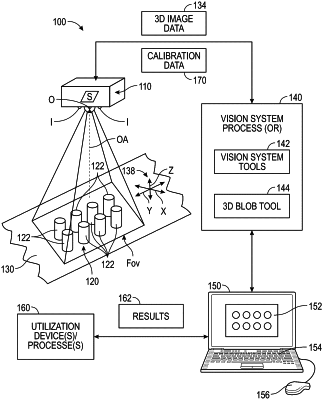| CPC G06T 1/0014 (2013.01) [G06T 7/0004 (2013.01); G06T 7/507 (2017.01); G06T 7/521 (2017.01); G06T 7/85 (2017.01); G06V 20/64 (2022.01); G06T 2207/10028 (2013.01); G06V 2201/12 (2022.01)] | 19 Claims |

|
1. A composite 3D blob tool for a vision system having a processor that receives acquired 3D image data from an object using a 3D camera assembly, the composite 3D blob tool comprising:
a blob tool process, stored in a computer memory accessible by the processor, that identifies positive 3D image data and negative 3D image data in the acquired 3D image data, and that combines the positive 3D image data from the acquired 3D image data that defines z-dimension height information and the negative 3D image data from the acquired 3D image data so as to thereby define at least one connected object,
wherein the negative 3D image data from the acquired 3D image data comprises, at least in part, a region of the acquired 3D image data with orthogonal x-y dimensions that define an absence of data with respect to the object and a shadow with respect to the object, and
wherein the z-dimension height information is used to refine the x-y dimensions of the object based on: (1) predetermined projection angles of illumination associated with the 3D camera assembly and received by an image sensor of the 3D camera assembly and (2) the location of the object in the field of view of the image sensor, so that a contribution of the shadow to the object is altered based on the refined x-y dimensions of the object.
|